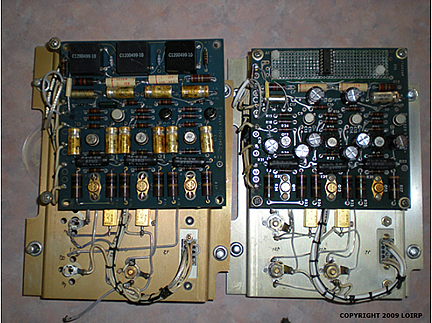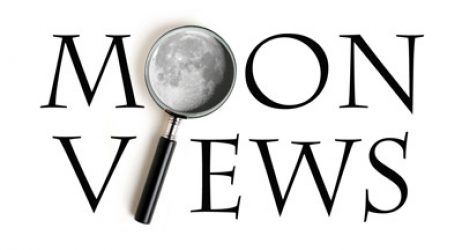Dennis Wingo and Keith Cowing at the LOIRP have been working to understand exactly what Lunar Orbiter 1 saw as it looked back at Earth on 23 August 1966. When LOIRP released its first retrieved image last year they included some attempts to correlate the Earth with rough boundries. In so doing they discovered that the time estimated back in 1966 was off by an hour or so. Dennis has now taken another stab at trying to understand what we all saw when Lunar Orbiter took this portrait of Earth. Click on image to enlarge. Image copyright 2009 LOIRP. Permission required for republication.
Image Archives
LOIRP Invited to Present at 2009 Santa Cruz Film Festival.
I am proud to announce that the LOIRP Image recovery project will be presenting a 3 minute video at the 2009 Santa Cruz Film Festival. This is a major northern California cultural event and probably the first time in 20 years that a space themed entry has been invited to present. This film festival is attended by thousands and the attendees represent the top tier of the cultural elite of the San Francisco and northern California, including the regents of the University of California system, political, and business leaders.
Website http://www.santacruzfilmfestival.org/
Our presentation will be themed “In Praise of Old Men”, which will be a 3 minute video, beginning with the original Lunar Orbiter program in the 1960’s and segueing to our image and video record of bringing the marvels of 1960’s technology back to life with a focus on the retirees who have been instrumental in our efforts. It is a praise of this incredibly competent generation that took us to the Moon, and who even in their golden years, are an inspiration to the younger generation in their abilities.
The video will end with some of the marvelous pictures of the Moon that we are getting now, and ending with an incredible image of the black and white Earth, lonely in the backdrop of space, derived from Lunar Orbiter I and V images.
At the end we will auction off three high resolution prints as part of a Charity event at the festival and our intrepid Center Director, Dr. Pete Worden will participate with the head of the film festival in the auction.
This will be a great way to bring the 60’s, the role of NASA in the popular culture of the era, and to honor the people who helped to make that a reality.
Dennis Wingo
LOIRP Project Lead
Lunar Orbiter Image Recovery Project (LOIRP) Progress Report 24 February 2009
Lunar Orbiter Image Recovery Project (LOIRP) Progress Report 23 February 2009

Refurbished capstan motor. Copyright 2009 LOIRP reproduction or republication prohibited without prior written permission.

Ken and Nathan working on refurbished capstan motor. Copyright 2009 LOIRP reproduction or republication prohibited without prior written permission.

Ken working on refurbished capstan motor. Copyright 2009 LOIRP reproduction or republication prohibited without prior written permission.
Lunar Orbiter Image Recovery Project (LOIRP) Progress Report 19 February 2009
To: LOIRP Status
From: Dennis Wingo
Subject: Progress Report, Milestone ALERT! Folks Major milestones to report!
Demodulator
We have had a major milestone accomplished (well 98% of the way there). Figure 1 shows two framelets, from Lunar Orbiter II High Resolution image (we don’t know which one yet). Figure 2 shows our favorite image, the Lunar Orbiter 1 image of the Earth with two framelets that were captured from the undemodulated tape. The framelets that are stitched together are from LO-1-102.
This proves that we can demodulate random tapes from more than one Lunar Orbiter mission but it has also shown us what we have to do to get to full production mode. The demodulator must be ultra stable, however, the drive is still not to its original specification and so there is jitter in the signal. The new capstan motor should fix this as we have new belts, bearings, and the motor has been balanced back to its original specification. However, the the motor driver assembly that we built to use during the calibration process blew some power transistors and he had to come back down (he is in San Francisco) and pick up one of our spares. We have been building spares for the production process to keep the machines running and this is helping with the refurb process as well! We will have the capstan motor on Saturday and will install and align it on Monday.
Al Sturm is going back and doing some further refining of the demodulator design to account for some loss of demodulator lock on the signal found during the testing yesterday. This accounts for the striping that you see on the Lunar Orbiter II framelets that we captured and processed shown on the next pages. We have not found out what frame this is and it is possible (as I have looked through all of the LO-II images) that we have one that is not in the current database as one image is missing from the LPL database that may be ours. If this is true, then we are helping to fill out the complete LO image database for NASA. One final note, look at the final image and see the boulders sitting on the surface at the edge of the crater!
Software
Gordon Woodcock has done some test automated assemblies of a couple of framelets which looks like it will result in a workable and at least semi-automated process for framelet reassembly.
Second Machine
We are continuing to install new caps and refurbished subassemblies that Ken and I have modified for better operation. It is our plan to finish the motor replacements, upgrades, and testing on the primary machine to get it ready for production before finishing up the second drive. This is as our experience gained on the first drive and the design upgrades will make the second drive relatively easy to get going after the learning curve of working on the first machine.
Images
Figure 1 is an unknown high resolution image from Lunar Orbiter II. These are individual framelets and we are still searching to figure out which whole image that it is attached to. The lines through the images are artifacts from the demodulator that is not quite 100% working – yet. The image has boulders sitting on the surface quite easy to see. We have verified that the intrinsic resolution of these images is going to be very high, to be quantified further after we get the demod at 100% and the capstan motor replaced. Figure 2 is a composite from LO-I-102-H that we processed from the undemodulated tape.
Figure 1: Unidentified high resolution framelet from Lunar Orbiter II. Image LOIRP/NASA

Figure 2: composite from LO-I-102-H Larger image. Image LOIRP/NASA
Discussion
We are closing in on satisfying all of the milestones from this phase of our project and we are looking forward to getting the go ahead and funding to enter the production phase. It is our plan to take a series of new images with us to the Lunar and Planetary Science conference in Houston to show what can be done with data mining these old data sets. We expect to be able to digitize any tape at will by next week and have a set of images that are the high priority outputs. I am extremely proud of our team and what has been accomplished and look forward to providing this raw data and finished products for NASA’s exploration and science efforts.
Respectfully Submitted
Dennis Ray Wingo
Lunar Orbiter Image Recovery Project (LOIRP) Progress Report 5 February 2009
We are still making progress and this report will outline what has happened since the last report on January 20.
General Statement
A bit of context is necessary here. The first machine continues to perform well. There are problems that were anticipated that we are dealing with. One of the overall reliability issues is that many electronic parts in the machine are customer Ampex hybrid circuits that are obviously not available anymore. Figure 1 shows what we have done to overcome this:

Figure 1: Capstan Motor Driver Assembly Before (left) and After (right) Modifications. Copyright 2009 LOIRP reproduction or republication prohibited without prior written permission.
Continue reading “Lunar Orbiter Image Recovery Project (LOIRP) Progress Report 5 February 2009”
Student Navigation Challenge: Charting a Course to the Moon

NASA Quest and the LCROSS mission invite you to register for Part II of the “Exploration through Navigation Challenge: Charting a Course to the Moon”. In this challenge students will be tasked to chart a course from Kennedy Space Center at Cape Canaveral, Florida to one of the lunar poles using navigation skills appropriate for outer space. The essential question used to keep students on task is “How do you stay on course?” [More]
Lunar Orbiter Image Recovery Project Update (LOIRP) 20 January 2009
At the start of a new year, here is a new formal report. A lot has happened since late December.
Funding
We finally got the funding in place and to us around the 17th of December that allowed us to pay vendors that were working with us on many parts. Their status as of today is as follows:
Heads
I just visited Video Magnetics in Colorado Springs, CO last week on another trip and they have made good progress. Here in figure 1 is a nice picture of Edwardo Lailao, the last guy in the world that still knows how to refurbish these heads:

Figure 1: Edwardo Lailao, VMI Rotating Head Engineering Lead
Continue reading “Lunar Orbiter Image Recovery Project Update (LOIRP) 20 January 2009”
NASA Radar Provides First Look Inside Moon’s Shadowed Craters
 Using a NASA radar flying aboard India’s Chandrayaan-1 spacecraft, scientists are getting their first look inside the moon’s coldest, darkest craters. The Mini-SAR instrument, a lightweight, synthetic aperture radar, has passed its initial in-flight tests and sent back its first data. The images show the floors of permanently-shadowed polar craters on the moon that aren’t visible from Earth. Scientists are using the instrument to map and search the insides of the craters for water ice. More
Using a NASA radar flying aboard India’s Chandrayaan-1 spacecraft, scientists are getting their first look inside the moon’s coldest, darkest craters. The Mini-SAR instrument, a lightweight, synthetic aperture radar, has passed its initial in-flight tests and sent back its first data. The images show the floors of permanently-shadowed polar craters on the moon that aren’t visible from Earth. Scientists are using the instrument to map and search the insides of the craters for water ice. More
FR-900 Pamphlet
Apollo Landing Sites Mapped by Chandrayaan

Nearly 40 years after Nasa’s Apollo flights, which put a man on the moon, India’s Chandrayaan mission launched on October 22, 2008, recently did something unique this week it mapped the landing sites of the six Apollo missions on the moon and the process ended on Saturday. The Apollo flights were launched between July 1969 and December 1972. [More]
Lunar Science Institute Picks Team

NASA has selected seven academic and research teams as initial members of the agency’s Lunar Science Institute. The institute supports scientific research to supplement and extend existing NASA lunar science programs in coordination with U.S. space exploration policy. The selection of the members encompasses academic institutions, non-profit research institutes, private companies, NASA centers and other government laboratories. [More]





